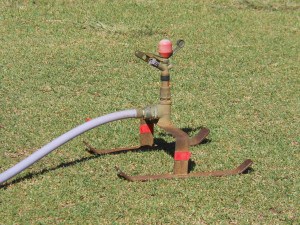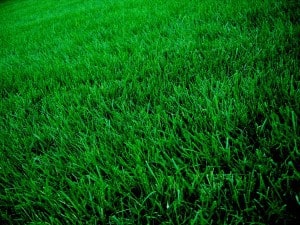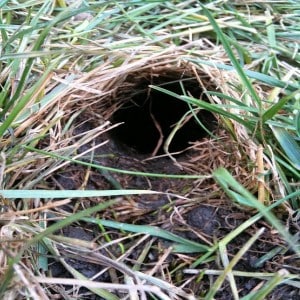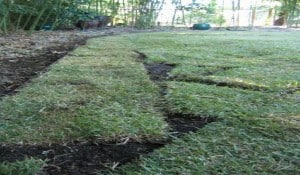Summary: This post is series of lawn care questions and answers we’ve put together from various emails sent in.
Question: What is a good lawn?
Answer: A good lawn is one that provides a good uniform appearance throughout the entire year. A good and beautiful lawn must be resistant to wear if it is going to be used in high traffic areas.
A good lawn should be weed-free. It should be a thick dense turf that will minimize injuries to active who use it like growing children.
A good lawn should keep mud and dust out of the house. A good lawn should be cut closely for maximum enjoyment and usage.
A good lawn is one that, when people walk on it, they say “Oh, just like a carpet.”
Question: I think my lawn needs fertilizer. What should I use, how much and when should I apply it?
Answer: Most lawns need far more fertilizer than they are receiving. It is impossible in a limited space and time to describe all of the recommended methods, rates and times of fertilizing lawns.
Read Our Article: Fertilizing And Feeding The Lawn
All of this information is easily available from experiment station bulletins and from local seed stores that follow experiment station recommendations. Also, the local golf course superintendent many times is in a position to help members of his club with their problems.
In general, it is far better to fertilize frequently using rather sparing amounts each time than to try to put on the whole season’s supply in one application.
Burning is one of the difficulties that home owners run into when fertilizing their lawns.
By using lighter amounts more frequently throughout the grass-growing season, danger of burning is minimized.
Question: Can I mix grass seed and lawn fertilizer together and sow it on a prepared seedbed?
Answer: This is a common practice. More at: Sowing Grass Seed
Question: Can grass seed be sown successfully in the fall after the time when we can expect germination?
Answer: Yes. This is called dormant seeding, and has been practiced for many years with a great deal of success.
Many times it is more convenient to cultivate (aerify the lawn) the soil late in the fall, lawn lime it and fertilize it, and sow grass seed even though one does not expect to see the grass seed germinate and grow until the following spring. Remember, this is a good recommended practice.
- Fall Fertilizer For Lawns Produces Spring Results
Question: Besides a lawn mower, what tools are essential for good lawn care?
Answer: Apart from mowing, certainly one needs a cultivating (aerifying) tool to open and loosen the soil for the ready penetration of lime, organic fertilizer, water and insecticides. There are several cultivating machines, coring machines and spikers on the market.
More On: Lawn Aeration
The local garden center can also give you good information on the best tools for organic lawn care. In addition, you ought to have a sod plugger to move plugs of good sod to the worn or bare places for immediate repair.

This really is far more effective during all seasons of the year than trying to re-establish grass by reseeding.
Certainly you will need a lawn cart or wheel barrow for hauling lime, lawn fertilizer, soil and other things.
Lawn care toolbox would not be complete without a good lawn broom or rake, and for my part, I like to have a leaf blower, something to remove excess grass clippings when they are heavy, and to remove leaves, twigs and other debris.
A fertilizer spreader is not absolutely necessary on a very small lawn because you can do the job by hand. For larger lawn areas a spreader is helpful.
Finally a weed eater or string trimmer helps to clean up the edges where a mower may not be able to reach.
Question: There are so many gadgets for watering lawns that I am confused. What is the best way?
Answer: The best lawn watering device is a sprinkler that puts the water down in an even pattern, uniformly, at a rate at which the soil can absorb it.
There is no use applying water faster than the soil can take it in.
You just get runoff and waste water that is very inefficient.
There are a great number of good lawn sprinklers on the market which throw a good pattern and deliver the water uniformly. More important than the watering device is how you use it.
More on Lawn Watering:
- Watering The Lawn – Best Practices Of Watering The Yard And Grass
- Tips On Lawn Watering and Irrigation
Water should be applied to a lawn only when the grass needs it, and then the soil should be soaked to a depth of about 6 inches. It should be allowed to become quite dry before water is again applied.

We must begin to learn how to save water rather than use it in abundance.
Question: Should I mulch my lawn? How about leaving clippings where they fall?
Answer: If the grass is thin and considerable bare soil is showing, by all means leave the clippings on the lawn.
But, when you have a good solid dense turf and you get a flush of growth in the spring, then it may be a good idea to remove the excess clippings.
Lawn fungus diseases develop under the clippings so rapidly that it is possible to ruin a stand of grass by leaving the clippings on for even a few days.
I like to remove the clippings because it is something like sweeping up the litter on the living room rug after the kids have been in there on a rainy afternoon.
Related Reading: Spring Lawn Care Services and Maintenance
Question: My lawn was full of crabgrass last year. How soon can I start fighting it this year and how?
Answer: The best way to start fighting crabgrass this year is to begin planting those grasses that can crowd out the crabgrass. In the north, where bluegrass is used, newer varieties of bluegrass will do a better job of fighting crabgrass than the common Kentucky bluegrass.
Farther south, where zoysia grass can be grown, we know that zoysia will fight crabgrass on its own terms and win. Still farther south, Bermuda grass and zoysia and other warm-season grasses can fight crabgrass if they are properly managed, proper lawn fertilizer applications and watered.
You can start fighting crabgrass on any day of the year when the ground is not frozen or bone dry. There are a number of chemicals on the market, many of which have given questionable results.
Properly, used, chemicals are a wonderful tool in helping get rid of crabgrass. But we still must grow the type of grass that will crowd out the crabgrass.
Why not check with your county agent or to local experiment station and ask them for their latest recommendations on weed control and controlling crabgrass in lawns. They may recommend pre-emergent herbicide or pre-emergent weed control to solve your problems with crabgrass.
Question: What’s the best way of feeding old thick turf? I’ve been told it is a good idea to punch holes with a spiked roller. Is it?
Answer: The best way to get lawn fertilizer into any kind of turf regardless of whether or not it is old or new, thick or thin, is to open, loosen and otherwise cultivate the soil to provide loose-walled cavities so the fertilizer can go deeply into the root zone.
If this is not done, lawn fertilizer will be lost by being washed away by rainfall. A spiked roller will help but, as the solid spikes enter the soil, they tend to compact the soil laterally rather than to loosen it and open it for rapid penetration of moisture and plant food.
There are several devices on the market, including spiked rollers, spiked discs, coring machines, and cultivating machines with curved open spoons.
Tests at experiment stations prove that cultivation of turf grass areas with the curved spoons is very effective in getting fertilizer deeply into the soil for greatest effectiveness.

Question: Are the new zoysia lawn grasses hardy in the north? Are they planted differently from the usual lawn seed mixtures?
Answer: Zoysia, is hardy in the north. However, when one gets into the bluegrass-fescue-bent territory, the zoysias tend to develop and grow so slowly that most people become quite discouraged with them.
Zoysiagrass is finding its greatest application in the twilight or transition zone between the northern or cool-season grasses and the southern or warm-season grasses. A belt a couple of hundred miles wide, roughly between Washington, D. C. and St. Louis, Missouri and south, is the ideal location at the present time for the zoysia grasses.
- Care For Empire Zoysia Turf Grass Spring: Video
- Growing Zoysia Grass – Maintenance Care Fertilizer and More
Here again, one should consult each individual experiment station or the local golf course superintendent to determine how the zoysia grasses are performing in that locality. Since there is no seed available of the zoysia grasses, most of the planting is done either by sprigs, by sod plugs or sod chunks.
Question: We made a new lawn last fall. What is the first thing we do this spring? Should we roll it?
Answer: Chances are that the rolling won’t do very much good.
In fact, it could do a lot of harm if you roll when the ground is too full of moisture. Probably the best thing to do first this spring is fertilizing the lawn.
As soon as the growth has started and the soil moisture is right, it would be an excellent time to cultivate (aerate) your lawn and then apply the fertilizer. The fertilizer will be more effective by reaching the roots through the loosened, cultivated soil.
The lawn that is properly covered with a dense, solid turf does not require rolling.
Question: Is there any way to fill in or raise and level the lawn in low spots in an old yard without making it over entirely?
Answer: Yes… The good sod in the low spots can be cut out or peeled back with a spade or sod lifter.
The soil underneath should be loosened and fertilized. Extra soil can be brought in to bring the low spot to a level grade, and then the sod can be replaced, tamped down firmly and watered.
The repair should be complete and permanent. Another way to do it without removing the sod is to use a fork implement to raise the sod. Then by frequent applications of screened topsoil, the level of the low spot can be brought up and the grass can be kept growing through the fine topsoil until you effect a final repair.
This will have to be done over a period of time, but it can be done effectively. Read More – Leveling The Lawn
Question: Is it practical to use tennis-court grass mixtures for home lawns where children give the grass hard wear? How long before such a lawn is well established?
Answer: The grasses used on tennis courts are not necessarily those that would withstand hard wear on the home lawn.
Here one should consult the authorities for the types of grasses that do best on athletic fields. The home lawn that gets hard wear from growing, active children is comparable with an athletic field.
For most of the northern part of the United States, bluegrass answers the description. But the bluegrass must be adequately managed with soil cultivation, liming the lawn and heavy fertilizing in order to make it withstand the heavy wear.
As you go south from the bluegrass area. you get into the fringe or transition area where an adapted bermdagrass or zoysia will best answer this hard-wear problem.
Such a lawn can be established even while it is being used. In the south, of course, bermuda grass gives the highest quality turf for hard wear. Remember, however, that the management accorded these grasses is actually more important in helping them to resist hard wear than the grasses themselves.
If they are starved, then one cannot expect them to stand tip under this type of use.
Question: What is the most practical way to eliminate moles from a lawn?
Answer: Deny the moles their favorite food, which are tasty lawn grub worms and other soil insects and the moles will leave and do their feeding on the neighbors’ lawns!
The best way to get rid of the soil-inhabiting insects on which moles feed is to use one of the new modern insecticides. Your state agricultural experiment station can advise on the one that is recommended.

Since the recommendations vary according to the type of insects you have, it would be best to consult with your experiment station, county agent. or local supplier.
Question: Many sections of my lawn are covered with moss. Does this mean that the soil is acid?
Answer: Not necessarily. A mossy lawn is usually due to poor drainage, not to acidity in the soil, as is widely believed. It probably is starved. Grass cannot grow unless it has plant food.
In the absence of plant food, the grass becomes thin and practically disappears and then the moss takes over. Large areas of my lawn were solid moss when I moved there in 1996.
By constant fertilizing, cultivating (aeration) the soil, reseeding or replanting with adapted grasses, the moss today is completely non-existent. Read Renovating Old Lawns
Question: Is it practical to sod an entire lawn? How does the cost compare with that of a seeded lawn?
Answer: The cost of a sodded lawn is very much higher than when the lawn is seeded. In some cases the consideration of immediate protection from mud and dust outweighs the added cost.
Unfortunately, in many cases sod that is used is not the kind of sod that is permanent and very quickly gives way to crabgrass and other weeds. Then the home owner is very dissatisfied and must go to the additional expense of re-establishing the lawn with adapted grasses.
If sodding is contemplated, first be sure that the sod is composed of the grasses that are completely adapted to the location. If they are not, then the sod ought to be refused and plans made for seeding the lawn to grasses that will be permanent.
Question: We have just moved to New Orleans and have bought a new home. As Northerners, we aren’t familiar with the best lawn grasses for the south. What do you think we should plant?
Answer: One of the grasses widely used for lawns in the south is St. Augustine grass. Another one that grows well is Bermuda grass when it is adequately fertilized.
The zoysia grasses have a place for lawns where the level of maintenance is likely to be low. Here again, wherever you go, if you are not familiar with the lawn grasses in that area, start talking to the county agent.
This should get you a pretty clear idea of what grasses are best adapted in your area.
Question: What time of year should I start a new lawn?
Answer: If one had a choice, it would be in late summer for the cool-season lawns and early spring for the lawns composed of the warm-season grasses such as centipede, St. Augustine, zoysia, and others.
Too often the new lawn must be started when the new home is finished, regardless of whether or not it is the most favorable time to plant the grasses adapted to that particular region.
When the new lawn must be planted in an off-season, it may be best to make thorough preparation and then make a seeding of temporary grasses. This serves to control erosion, mud and dust until the proper time to establish the adapted perennial or permanent grasses.
Question: How do I know what kind of grass seed or mixture to select?
Answer: Every state agricultural experiment station has information on this, usually in the form of bulletins, distributed through the state agriculture extension service.
Most reputable grass seed vendors depend upon the experiment stations for up-to-date information, and their advice on seed mixtures usually follows the experiment station’s recommendations.
A good rule of thumb in selecting any grass seed or mixture is that the major part of the mixture should contain perennial or permanent grasses, that will make up the permanent lawn.
Question: If I can’t start a permanent lawn now, is there any sort of seed I can sow for a temporary effect?
Answer: Yes, in most cases ryegrass is the quickest growing temporary cover. It controls erosion, mud and dust until it is lime to plant the permanent grasses. This is one of the best uses for ryegrass.
I would far rather use it in this connection than in a mixture of permanent grasses where it actually becomes a “smother” crop and retards the development of the permanent grasses.
Question: If I am going to make a new lawn in the fall, is there anything I should do now toward preparing the soil?
Answer: Yes… The soil for a late summer or early fall planting of cool-season grasses can be put into shape while the seedbed is being prepared for the temporary sowing of ryegrass. Ample lime, if it is needed according to the soil test and plenty of fertilizer should be worked thoroughly into the soil to a depth of 4 to 6 inches.
There should be ample soil fertility, not only to grow the temporary cover of ryegrass, but to have a good reserve in the soil to promote the growth of permanent grasses when they are planted in the fall.
Question: What kind of soil is best for a lawn?
Answer: The best answer to this is the – kind of soil that is already there.
In general, topsoil is not required for the development of good lawn turf. Topsoil too often is thought of as being synonymous with fertile soil, when actually quite the reverse may be true.
Much “topsoil” that I have seen has come from somebody’s cleared lot or basement excavation. It is called “topsoil” when it is delivered to the lawn and placed on top of the existing soil.
Related Reading: Lawn Soil – Understanding Soil Conditions For Growing Healthy Grass and Turf
If cost was not a consideration to achieve a healthy lawn and you were able to get a particular kind of soil, then it would be possible to say that a medium sandy loam would be the best for a lawn.
However, that is not necessary, for with our present day knowledge of cultivation and fertilization of soils and with the better grasses that we have today. We can make an acceptable lawn on almost any kind of soil that occurs in the locality.
But.. Good Lawn Soil – A Pantry Of Soil Rich Nutrients
Question: Can I grow grass on a steep slope?
Answer: Yes… if you select the kind of grass that is adapted to the particular type of slope. One of the reasons that grasses do not grow well on steep slopes is that the water runs off, leaving the soil too dry for the best growth of grass.

Also, much of the fertilizer is washed away, if the fertilizer is put there in the first place. It is just as easy to grow grass on a slope as on level ground if the basic principles of cultivating (aerifying) the soil, liming and fertilizing, and adequate watering are followed.
However, because of the droughty nature of slopes and the runoff of rainfall, it will pay to select those grasses that are most drought and heat-resistant.
In the north, these grasses are Kentucky bluegrass, Kentucky & fescue and red fescue.
In the mid-south or transition zone, one of the better grasses for slopes, especially south-facing slopes, is zoysia. Bermuda grass, where it is desired, makes an acceptable slope grass because it fulfills the qualifications.
Farther south, any of the warm-season grasses such as centipede. Bermuda. zoysia and St. Augustine may be used.
Question: The grass under my large trees never does well. What can I do about it?
Answer: One of the reasons that grass fails to do well under large trees is because of the competition for water, plant food and light. The tree gets first call on all of these requirements for good grass growth.
In my case, I follow the practice of thoroughly cultivating (aerifying) the soil several times a season. Also… I select the grasses that are best able to grow under those conditions.
Third… I fertilize more generously under the big trees because you have to feed both the tree and the grass. However, I tend to concentrate my fertilizer during that period of the year when the tree is making the least demands for water, plant food and light.
Question: The grass under our trees will not grow. We use lake water and liquid fertilizer. Are we doing the right thing or do we need special grass for shady areas? JC, Indiana
Answer: In shady areas growing good turf is difficult and if there is no direct sunlight at all it is better to use ground cover plants. Both the lake water and liquid fertilizer which you are using are ideal for lawn maintenance.
Bear in mind that grass grown in shade has less roots than that grown in the sun and the more shade the less roots.
More Reading: Problems of Growing Grass in Shade
Therefore, to keep the grass growing in shade there must be good underdrainage and loose porous soil so that watering can be done often without puddling the soil.
The soil must be kept fertile so the limited root system can find both moisture and food. Two feedings, once in the spring and once in the fall, should be given. Humus such as peat moss or rotted stable dressing should be added to shady areas each spring or late fall.
Blends of special grasses may help to maintain a lawn under trees. Fescue is excellent. Seed the lawn now with Kentucky blue grass and then in the spring add a seeding of tall fescue.
You can also call for help of professional lawn care companies to solve an uncontrollable lawn problem or infestation. A good lawn care company offers a wide range of lawn care program to match your lawn care requirements.
Image: net_efekt | mikecogh | hummyhummy | David Reber’s Hammer Photography




